Philippine Navy
| Philippine Navy | |
|---|---|
Hukbong Dagat ng Pilipinas Armada de Filipinas | |
 Seal of the Philippine Navy | |
| Founded | May 20, 1898 (1898-05-20)[1] |
| Country | |
| Type | Navy |
| Size | 25,370 active personnel (including 7,500 marines)[2] 15,000 Reserve Personnel |
| Part of | Armed Forces of the Philippines |
| Headquarters | Naval Station Jose Andrada, City of Manila |
| Ships | 3 frigates (+2 under construction) 10 corvettes (+1 for delivery, +2 for acquisition) 2 landing platform dock 4 landing support ships 10 heavy landing crafts 35 patrol craft 9 Fast assault craft 1 oceanographic research ship |
| Engagements | Philippine Revolution Spanish–American War Philippine–American War World War II Communist Insurgencies Moro conflict Spratly Islands Dispute Scarborough Shoal standoff |
| Website | www.navy.mil.ph |
| Commanders | |
| Commander-in-Chief | President Rodrigo Roa Duterte |
| Secretary of National Defense | Delfin Lorenzana |
| Chief of Staff | Gen. Benjamin Madrigal Jr., AFP |
| Flag Officer in-Command | Vice Admiral Robert Empedrad , PN |
| Insignia | |
| Pennant | |
| Jack |  |
| Flag |  |
| Patch |  |
| Aircraft flown | |
| Helicopter | AgustaWestland AW109 Power, AgustaWestland AW159 Wildcat, MBB Bo 105C, Robinson R22 |
| Patrol | BN-2 Islander, Beechcraft King Air, Cessna 172 |
The Philippine Navy (PN; Filipino: Hukbong Dagat ng Pilipinas; Spanish: Armada de Filipinas) is the naval warfare service branch of the Armed Forces of the Philippines. It has an estimated strength of 24,000 active service personnel, including the 7,500-strong Philippine Marine Corps.[2] It shares the responsibility of patrolling the maritime borders with the Philippine Coast Guard, its former attached unit until the latter became a separate maritime law enforcement agency on 1998.
Contents
1 Mission
2 History
2.1 Pre-colonial period
2.2 Foreign Occupation
2.2.1 The Spanish Colonial Era
2.2.2 American Colonial Period
2.2.3 World War 2 and Japanese Occupation
2.3 Post-War and Philippine Independence
2.3.1 AFP Restructuring and Philippine Navy Establishment
2.4 Cold War
2.4.1 The Korean War
2.4.2 Early Philippine-Korean Naval relationship
2.4.3 Internal Security Focus
2.4.4 US Military Departure from the Philippines
2.5 Contemporary Era
2.5.1 Chinese threats to the Philippine claims in the South China Sea
2.5.2 The AFP Modernization Efforts and the Asian Financial Crisis
2.5.3 The Philippine-US Visiting Forces Agreement
2.5.4 The 2012 Scarborough Shoal Incident
2.5.5 The South China Sea Arbitration Case and Revised AFP Modernization Program
2.5.6 US-Philippine Enhanced Defence Cooperation Agreement
3 Organization
3.1 Leadership
3.2 Type Commands
3.2.1 Philippine Fleet
3.2.2 Philippine Marine Corps
3.3 Naval Operational Commands
3.4 Naval Support Commands
3.4.1 Naval Sea Systems Command
3.4.2 Naval Education and Training Command
3.4.3 Naval Reserve Command
3.4.4 Naval Combat Engineering Brigade
3.4.5 Naval Installation Command
3.5 Naval support units
4 Equipment
4.1 Naval Vessels
4.2 Naval Aircraft
4.2.1 Units
4.2.2 Aircraft
5 Bases
5.1 Naval bases
5.2 Naval stations
5.3 Marine bases
6 Future of the Philippine Navy
6.1 Multi-purpose attack crafts (MPAC)
6.2 Multipurpose patrol vessels
6.3 Submarine
6.4 Anti-submarine helicopters
6.5 Frigates
6.6 Corvettes
6.7 Amphibious assault vehicles
6.8 Missiles and other Weapons Systems
7 Gallery
8 See also
9 References
10 External links
Mission
.mw-parser-output .templatequote{overflow:hidden;margin:1em 0;padding:0 40px}.mw-parser-output .templatequote .templatequotecite{line-height:1.5em;text-align:left;padding-left:1.6em;margin-top:0}
"To organize, train, equip, maintain, develop and deploy forces for prompt and sustained naval and maritime.
operations in support of the Unified Commands in the accomplishment of the AFP mission".
— Based on the 2007 Integrity Development Review of the AFP–Philippine Navy by the EC–OMB Corruption Prevention Project[3]
Its powers and functions are as follows:[4]
- "To organize, train, equip, maintain and operate naval forces and naval aircraft including naval reserve units, necessary to provide water-borne support and assistance required by the Armed Forces of the Philippines in the accomplishment of its mission"
- "To assist the proper governmental agencies in the enforcement of laws and regulations pertaining to navigation, immigration, customs revenue, opium, quarantine, fishing and neutrality in the territorial and contiguous waters of the Philippine Archipelago"
- "To develop, in coordination with the other major services and area commands the doctrines, procedures, and naval equipment for joint operations, and the doctrines and procedures for amphibious operations"
History
Pre-colonial period
Before the Spanish arrived in the Philippines the ancient peoples there were engaging in naval warfare, trade, piracy, travel and communication using balangay.[5] A flotilla of balangay was discovered in the late 1970s in Butuan City, Agusan del Norte.[6]

A Karakowa ancient Battleship with Lantaka Cannons.
Philippine ships, such as the karakao or korkoa were of excellent quality and some of them were used by the Spaniards in expeditions against rebellious tribes and Dutch and British forces. Some of the larger rowed vessels held up to a hundred rowers on each side besides a contingent of armed troops. Generally, the larger vessels held at least one lantaka at the front of the vessel or another one placed at the stern. Philippine sailing ships called praos had double sails that seemed to rise well over a hundred feet from the surface of the water. Despite their large size, these ships had double outriggers. Some of the larger sailing ships, however, did not have outriggers.[7]
Antecedent to this raids, sometime between A.D. 1174 and 1190, a traveling Chinese government bureaucrat Chau Ju-Kua reported that a certain group of "ferocious raiders of China’s Fukien coast" which he called the "Pi-sho-ye," believed to have lived on the southern part of Formosa.[8]
In A.D. 1273, another work written by Ma Tuan Lin, which came to the knowledge of non-Chinese readers through a translation made by the Marquis D’Hervey de Saint-Denys, gave reference to the Pi-sho-ye raiders, thought to have originated from the southern portion of Formosa. However, the author observed that these reaiders spoke a different language and had an entirely different appearance (presumably when compared to the inhabitants of Formosa).[8]
In the Battle of Manila in 1365 is an unspecified and disputed battle occurring somewhere in the vicinity of Manila between the forces of the Kingdoms in Luzon and the Empire of Majapahit.
Even though the exact dates and details of this battle remain in dispute, there are claims of the conquest of the area around Saludong (Majapahit term for Luzon and Manila) according to the text Nagarakretagama[9]
Nevertheless, there may have been a battle for Manila that occurred during that time but it was likely a victory for Luzon's kingdoms considering that the Kingdom of Tondo had maintained its independence and was not enslaved under another ruler. Alternatively, Luzon may have been successfully invaded but was able to regain its independence later.[10][11]
Foreign Occupation
The Spanish Colonial Era
The Republic's need for a naval force was first provided for by Filipino revolutionaries when they included a provision in the Biák-na-Bató Constitution. This authorised the government to permit privateers to engage foreign enemy vessels.[12]
(w)hen the necessary army is organized … for the protection of the coasts of the Philippine archipelago and its seas; then a secretary of the navy shall be appointed and the duties of his office added to this Constitution.
— Gen. Emilio Aguinaldo on the Biák-na-Bató Constitution[12]
On May 1, 1898, the first ship handed by Admiral George Dewey to the Revolutionary Navy is a small pinnace from the Reina Cristina of Admiral Patricio Montojo, which was named Magdalo.[12]
The Philippine Navy was established during the second phase of the Philippine Revolution when General Emilio Aguinaldo formed the Revolutionary Navy which was initially composed of a small fleet of eight Spanish steam launches captured from the Spaniards. The ships were refitted with 9 centimeter guns. The rich, namely Leon Apacible, Manuel Lopez and Gliceria Marella de Villavicencio, later donated five other vessels of greater tonnage, the Taaleño, the Balayan, the Bulusan, the Taal and the Purísima Concepción. The 900-ton inter-island tobacco steamer further reinforced the fleet, Compania de Filipinas (renamed as the navy flagship Filipinas), steam launches purchased from China and other watercraft donated by wealthy patriots.[12][13]
Naval stations were later established to serve as ships' home bases in the following:[13]
- Ports of Aparri
- Ports of Legaspi
- Ports of Balayan
- Ports of Calapan
- Ports of San Roque, Cavite
On September 26, 1898, Aguinaldo appointed Captain Pascual Ledesma (a merchant ship captain) as Director of the Bureau of the Navy, assisted by Captain Angel Pabie (another merchant ship captain). After passing of the Malolos Constitution the Navy was transferred from the Ministry of Foreign Relations to the Department of War (thereafter known as the Department of War and the Navy) headed by Gen. Mariano Trías.[12][13]
As the tensions between Filipinos and Americans erupted in 1899 and a continued blockade on naval forces by the Americans, the Philippine naval forces started to be decimated.[12]
American Colonial Period
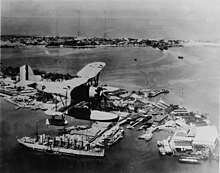
A U.S. Navy Vought O2U Corsair floatplane flying over the Cavite Navy Yard, c. 1930.
The American colonial government in the Philippines created the Bureau of the Coast Guard and Transportation, which aimed to maintain peace and order, transport Philippine Constabulary troops throughout the archipelago, and guard against smuggling and piracy. The Americans employed many Filipino sailors in this bureau and in the Bureaus of Customs and Immigration, Island and Inter-Island Transportation, Coast and Geodetic Survey, and Lighthouses. They also reopened the former Spanish colonial Escuela Nautica de Manila, which was renamed the Philippine Nautical School, adopting the methods of the United States Naval Academy at Annapolis. The U.S. Naval Academy accepted its first Filipino midshipman in 1919, and Filipinos were able to enlist in the U.S. Navy, just as they were formerly able to do in the Spanish Navy.[12]
World War 2 and Japanese Occupation
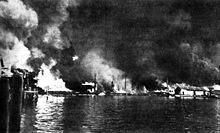
Sangley Point Cavite Navy Yard burning after a Japanese air attack on 10 December 1941. Small-arms shells explode (left) and a torpedo-loaded barge (center) burns.
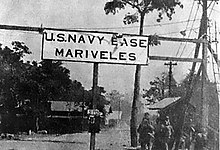
Mariveles Naval Section Base was used by the US Navy's Asiatic Fleet during the Second World War.
In 1935, the Commonwealth Government passed the National Defense Act, which aimed to ensure the security of the country. This was criticized because it placed the burden of the defense of the Philippines on ground forces, which in turn, was formed from reservists. It discounted the need for a Commonwealth air force and navy, and naval protection was provided by the United States Asiatic Fleet.[12]
"A relatively small fleet of such vessels, ...will have distinct effect in compelling any hostile force to approach cautiously and by small detachments."
— Gen. Douglas MacArthur, Military Advisor to the Philippines regarding the newest Offshore Patrol (OSP) PT boats[14]
When World War II began, the Philippines had no significant naval forces after the United States withdrew the Asiatic Fleet following the attack on Pearl Harbor by the Imperial Japanese Navy. The Philippines had to rely on its OSP with headquarters located at Muelle Del Codo, Port Area, Manila, composed of five high-speed Thorneycroft Coast Motor Boat (CMB) 55-foot (17 m) and 65-foot (20 m) PT boats, also known as Q-boats, to repel Japanese attacks from the sea.[12][13]
During the course of the war, the OSP were undaunted by the enemy's superiority which they fought with zeal, courage and heroism. For its intrepid and successful missions and raids on enemy ships, the unit was dubbed the "Mosquito Fleet" mainly because of its minuscule size, speed and surprise, it shown its capability to attack with a deadly sting. The unit was cited for gallantry in action when its Q-boats Squadron shot three of nine Japanese dive bombers as they were flying towards shore installations in Bataan.[15] The OSP participated in the evacuation of high Philippine and U.S. government officials from Manila to Corregidor when Manila was declared an open city.[16]
Surviving personnel of the Offshore Patrol that didn't surrender after April 9, 1942 to the Japanese, conducted the recognized guerrilla and local military troops of the Philippine Commonwealth Army were hit-and-run attacks against the occupying Japanese forces until the return of U.S. Forces.[12] By the end of the war, 66 percent of its men were awarded the Silver Star Medal and other decorations for gallantry in action.
Post-War and Philippine Independence
In 1945, after the liberation of the Philippines, the OSP was reactivated and led by Major Jose Andrada, to reorganize and rebuild from a core of surviving OSP veterans, plus additional recruits. The OSP was strengthened in 1947 after President of the Philippines Manuel Roxas issued Executive Order No. 94. This order elevated the Patrol to a major command that was equal with the Philippine Army, Constabulary, and Air Force. The OSP was renamed the Philippine Naval Patrol, later on changed its name again to the Philippine Navy on January 5, 1951. The first commanding officer of the Navy, Jose Andrada, became its first Commodore and Chief.[12][13] This was also the year when the naval aviation arm of the Navy was formed, now the Naval Air Group.
@media all and (max-width:720px){.mw-parser-output .tmulti>.thumbinner{width:100%!important;max-width:none!important}.mw-parser-output .tmulti .tsingle{float:none!important;max-width:none!important;width:100%!important;text-align:center}}

RPS Rajah Soliman (D-66), flagship of Philippine Navy from 1960-1964


In 1950, Secretary of Defense Ramon Magsaysay created a marine battalion with which to carry out amphibious attacks against the Communist Hukbalahap movement. The next year, President Elpidio Quirino issued Executive Order No. 389, re-designating the Philippine Naval Patrol as the Philippine Navy. It was to be composed of all naval and marine forces, combat vessels, auxiliary craft, naval aircraft, shore installations, and supporting units that were necessary to carry out all functions of the service.[12]
In the succeeding decades, the Philippine Navy organized the following units (aside from the Marines):
- Naval Shore Establishment
- Naval Operating Forces
- Philippine Coast Guard
- Home Defense Command
- Military Sealift and Terminal Command
Cold War
The Korean War
On Sunday June 25 1950, the existence of the Republic of Korea as a democratic nation was shattered when armored and infantry elements of the North Korean People’s Army crossed the border into Seoul. The surprise attack caught off guard the Republic of Korea Armed Forces who lacked the equipment to withstand a massive communist invasion.
On that same day, the United Nations Security Council Resolution Number 82 was enacted which called for the immediate withdrawal of the belligerent forces from South Korea. It went unheeded prompting the world body to pass UNSC Resolution number 83 calling on member countries to support militarily the ROK in deterring communist aggression.
Although having its own counter insurgency problem, the Philippines became the first South East Asian country to deploy troops in support of the UN cause and the third member of the UN body to do so.. On September 7 1950 President Elpidio Rivera Quirino announced the historic decision of the deployment of Filipino Soldiers to the embattled republic. It fulfilled the country’s obligation as a member and signatory of the United Nations and combating the spread of communism in the Asia-Pacific region.
Unknown to many, the Philippine Navy (PN) would actively participate in the Korean War. The five landing ships tank (LST’s) of the Service Squadron of the Philippine Navy namely RPS Cotabato (T-36) RPS Pampanga (T-37), RPS Bulacan (T-38), RPS Albay (T-39) and RPS Misamis Oriental (T-40) would serve as workhorses in transporting the Filipino soldiers to and from Korea for five years. Another great significance for the service was the assignment of two Filipino naval officers; LCDR Emilio S. Liwanag with the 10th BCT PEFTOK unit and later to the Philippine Liaison Group-United Nations Command in Tokyo, Japan. Later succeeded by CDR Santiago C. Nuval (PMA '38).
Quite unknown in the early days of the ROK, and the formation of the Korean Naval Defense Corps to the Korean Coast Guard (later becoming the Republic of Korea Navy), Filipino Naval Officers played a pivotal role as its brought in the first ships of the KCG to Korea from Subic Bay Naval Base. It was in August 1947 that then LTSG Ramon A. Alcaraz PN (PMA ’40) was designated as head of mission to ferry former US and British Royal Navy Auxiliary Motor Minesweepers that would form the backbone of the Korean Fleet, wherein their ports of destination were 3 of the 7 ROK Naval bases namely Chinhae, Pusan and Seoul. Another notable skipper of one of the ships to be transferred is LT Dioscoro E. Papa PN (the Second Commandant of the Philippine Coast Guard). Later on, at the outbreak of the Korean War in June 1950 now Commander Alcaraz would be the Service Squadron Skipper in which 5 PN Landing Ship Tanks (LST’s) served as the mainstay of the fleet in ferrying troops of the Philippine Expeditionary Force to Korea (PEFTOK) Battalion Combat Teams.
A notable naval role was the presence of then LCDR Emilio S. Liwanag PN (PMA ’38) as the Army's logistics and artillery officer of the 10th Battalion Combat Team (BCT) who commanded a battery of 105 mm howitzers during the Battle of Yultong. Liwanag was a graduate of the Advanced Infantry Gunnery Course at Fort William McKinley in 1950 days prior to his deployment to Korea. Early on, as logistics officer LCDR (Army Major) Liwanag was also responsible in securing from an American depot a squadron of US made M24 Chafee light tanks and heavy weapons for the battalion reconnaissance and heavy weapons company. Immediately after finishing his Army tour with the 10th BCT, Liwanag rejoined the navy ranks and was assigned as the senior naval advisor to the Philippine Diplomatic Representative for the Philippine Embassy. Along with the additional duty of being the Philippine Liaison Officer to United Nations Command Headquarters in Tokyo, Japan. During his duties in Japan, Liwanag was promoted to the rank of commander and later became the first Filipino officer to receive the US Legion of Merit medal for the Philippine Republic.
Internal Security Focus
During the 1960s, the Philippine Navy was one of the best-equipped navies in Southeast Asia. Many of the countries in the region gained independence between World War II and the 1960s. In 1967, the maritime law enforcement functions of the Navy were transferred to the Philippine Coast Guard. The duties stayed with the coast guard and in the 1990s it became an independent service under the Department of Transportation and Communications.[12]
After the 1960s, the government had to shift its attention towards the Communist insurgency and this led to the strengthening of the Philippine Army and the Philippine Air Force while naval operations were confined to troop transport, naval gunfire support, and blockade.[12]
US Military Departure from the Philippines
The Cold War Era had reached its endpoint as tensions between the two ideological rivals, the United States and the Soviet Union, simmered down as a result of the dissolution of the latter and the massive change of political system among its allies.



Naval Base Subic Bay (top and mid) and the Naval Air Station Cubi Point (bottom) near Olongapo City during the US military presence in the Philippines.
The fate of the US military bases in the country was greatly affected by these circumstances, aside from the catastrophic eruption of Mount Pinatubo in 1991 which engulfed the installations with ash and lava flows. The nearby Clark Air Base was eventually abandoned afterwards, while the Philippine Senate voted to reject a new treaty for Subic Naval Complex, its sister American installation in Zambales. This occurrence had effectively ended the century-old US military presence in the country, even as President Corazon Aquino tried to extend the lease agreement by calling a national referendum, leaving a security vacuum in the region and terminated the inflows of economic and military aid into the Philippines.
[17][18]
Contemporary Era
Chinese threats to the Philippine claims in the South China Sea
Concerns about the Chinese incursion to the sea features claimed by the Philippines and other Southeast Asian states were more pronounced in the last years of the 20th century. This was more evident after the Chinese construction of a military outpost at the Mischief Reef on 1995. As a response, the Philippine Navy dispatched the BRP Sierra Madre and deliberately ran it aground in the Second Thomas Shoal, 5 miles from the Chinese facility and south of the rumored oil-rich Reed Bank, which it maintains as its own station today.[19][20] However it remains unable to protect other Philippine Reefs that have been reclaimed by the Chinese.[21]
The AFP Modernization Efforts and the Asian Financial Crisis
The importance of territorial defense capability was highlighted in the public eye in 1995 when the AFP published photographs of Chinese structures on Mischief Reef in the Spratlys.
Initial attempts to improve the capabilities of the armed forces happened when a law was passed in the same year for the sale of redundant military installations and devote 35 percent of the proceeds for the AFP upgrades. Subsequently, the legislature passed the AFP Modernization Act. The law sought to modernize the AFP over a 15-year period, with minimum appropriation of 10-billion pesos per year for the first five years, subject to increase in subsequent years of the program. The modernization fund was to be separate and distinct from the rest of the AFP budget.
The Asian Financial Crisis which struck the region on 1997, greatly affected the AFP Modernization Program due to the government's austerity measures meant to turn the economy around after suffering from losses incurred during the financial crisis.[22]
Several major ship classes acquired by the Philippine Navy thru the original AFP Modernization Program of 1995 were the Jacinto class corvette, the Tarlac class LPDs, and the Gregorio del Pilar-class frigate.
[23]
The Philippine-US Visiting Forces Agreement

Construction of basic infrastructure projects as part of the annual Balikatan exercises.
In 1998, following the bases' closure, the Philippines-US Visiting Forces Agreement (VFA) was signed which contained guidelines for the conduct and protection of American troops visiting the Philippines and stipulated the terms and conditions for the American military to enter Philippine territory. The VFA is a reciprocal agreement that also outlines the requirements for Philippine troops visiting the United States. The Visiting Forces Agreement led to the establishment of the Balikatan exercises, an annual US-Philippine military exercise, as well as a variety of other cooperative measures including the Philippine Bilateral Exercises (PHIBLEX) between the naval forces of the two countries.[24][25]
The 2012 Scarborough Shoal Incident
The next decade ushered-in a cordial relationship between China and its maritime neighbours including the Philippines until 2011 when tensions rose again after consecutive incidents occurred in the disputed territories. In 2012, a Philippine surveillance aircraft identified Chinese fishing vessels at the then Philippine-controlled Scarborough Shoal, causing the Philippine Navy to deploy the BRP Gregorio Del Pilar to the area. In response, China sent surveillance ships to warn the Navy to leave the area claimed by both countries, prompting a standoff. The two nations eventually agreed to withdraw their deployed vessels as the arrival of the typhoon season drew near.
[26][27]
Following a 3-month standoff between Philippine and Chinese vessels around Scarborough Shoal, China informed the Philippines that Chinese coast guard vessels will remain permanently on the shoal as an integral part of their 'Sansha City' in the Woody island of the Paracels, a separate archipelago disputed by China and Vietnam. Under the control of Hainan Province. the Chinese government plans the island-city to have administrative control over a region that encompasses not only the Paracels, but Macclesfield Bank, a largely sunken atoll to the east, and the Spratly Islands to the south.[28]
The South China Sea Arbitration Case and Revised AFP Modernization Program
The incidents with the Chinese presence in the South China Sea prompted the Philippines to proceed with formal measures while challenging the Chinese activities in some of the sea features in the disputed island chain. Hence, the South China Sea Arbitration Case was filed by the Philippines in 2013 at the International Tribunal for the Law of the Sea (ITLOS).[29]
Reminiscent to what occurred on 1995, the Congress passed the Revised AFP Modernization Act of 2012, this was meant to replace the older AFP Modernization Act of 1995 signed during former Pres. Fidel V. Ramos’ term, when its 15-year program expired in 2010.[30]
Major naval assets programed for acquisition in this new modernization program iteration are 2 new frigates and its shipborne AW159 anti-submarine helicopters, among other equipment.[31]
US-Philippine Enhanced Defence Cooperation Agreement
On April 2014, the Enhanced Defense Cooperation Agreement was signed by the representatives of the Philippine and US Governments, aimed at bolstering the military alliance of both countries. The agreement allows the United States to rotate troops into the Philippines for extended stays and allows the U.S. to build and operate temporary facilities on Philippine military bases for both American and Philippine forces' use.[32][33]
Both parties agreed to determine the military installations across the Philippines as covered by the pact, including the former US Subic Bay Naval Base and Clark Air Base, as well as several locations on Cebu, Luzon, and Palawan.
[34]
Organization

Philippine Navy Headquarters facade, 2013
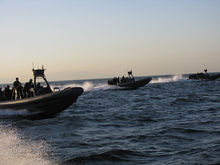
Philippine Navy rigid hull inflatable boats perform a maritime interdiction operation exercise in Manila Bay.
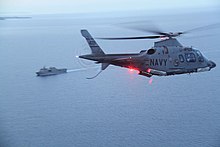
An AW109E naval helicopter approaches one of the Philippine Navy's Tarlac-class landing platform dock during an exercise in 2018
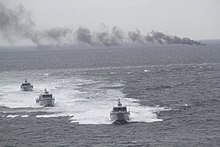
Missile-armed MPAC Mk. III attack boats during a live fire demonstration involving the launching of Spike-ER missiles in November 2018
The Philippine Navy is administered through the Department of National Defense (DND). Under the AFP structure, the Chief of Staff, AFP (CSAFP), a four-star general/admiral (if the officer is a member of the Philippine Navy), is the most senior military officer. The senior naval officer is the Flag Officer-in-Command (FOIC), usually with a rank of vice admiral. He, along with his or her air force and army counterparts, is junior only to the CSAFP. The FOIC is solely responsible for the administration and operational status of the Navy. The FOIC's counterpart in the U.S. Navy is the Chief of Naval Operations.[13][35]
Currently the navy establishment is actually composed of two type commands, the Philippine Fleet and Philippine Marine Corps (PMC). It is further organized into seven naval operational commands, five naval support commands, and seven naval support units.[35] Considering the vastness of the territorial waters that the Navy has to protect and defend, optimal deployment of naval resources is achieved through identification of suitable locations where the presence of these units are capable of delivering responsive services.[13][35]
The Philippine Fleet, or simply the "Fleet", is under the direct command of the Commander Philippine Fleet while the marine corps is answerable to the commandant, PMC (CPMC). The Flag Officer-In-Command (FOIC) has administrative and operational control over both commands.[13]
Leadership
- Flag Officer-In-Command- Vice Admiral Robert A. Empedrad (Incumbent Since Dec 19, 2017) [36]
Type Commands
The two Type Commands of the Philippine Navy are the:
- Philippine Fleet
- Philippine Marine Corps
Philippine Fleet
The Philippine Navy has only one fleet, the Philippine Fleet. As a type command, the fleet has nine major units:[35]
- Offshore Combat Force
- Littoral Combat Force
- Sealift and Amphibious Force
- Submarine Group
- Naval Air Group (NAG)
Naval Special Operations Group (NAVSOG) also known as Philippine Navy SEALs
- Fleet Support Force (formerly the Fleet Support Group)
- Fleet Training and Doctrines Center (FTDC)
- Naval Meteorological and Oceanographic Center (NAVMETOC)
Philippine Marine Corps
The Philippine Marine Corps evolved from a company of volunteers to three Marines Brigades, eleven Marine Battalion Landing Teams, a Combat and Service Support Brigade, one Reconnaissance Battalion, Training Center, Headquarters Battalion, Marine Security Escort Group and Marine Reserve Brigades, and various support and independent units.[37]
The seven Naval Operation Commands are as follows:[35]
- Naval Forces Northern Luzon (NAVFORNOL)
- Naval Forces Southern Luzon (NAVFORSOL)
- Naval Forces West (NAVFORWEST)
- Naval Forces Central (NAVFORCEN)
- Naval Forces Western Mindanao (NAVFORWESM)
Naval Forces Eastern Mindanao (NAVFOREASTM)- Fleet Marine Ready Force
NAVFORWEM and NAVFOREM were formed in August 2006 when Southern Command was split to allow more effective operations against Islamist and Communist rebels within the region.[38]
The five Naval Support Commands are as follows:[35]
- Naval Sea Systems Command (NSSC)
- Naval Education and Training Command (NETC)
- Naval Reserve Command (NAVRESCOM)
- Naval Combat Engineering Brigade (NCEBde)
- Naval Installation Command (NIC)
The Naval Sea Systems Command (NSSC), formerly known as Naval Support Command (NASCOM), provides quality and integrated naval system support and services in order to sustain the conduct of naval operations. It is the biggest industrial complex of the Armed Forces of the Philippines. It operates the country's military shipyards, develops new technologies for the Navy, and conducts maintenance on all the Navy's ships. NSSC's principal facilities are at the offshore operating base at Muelle de Codo and at Fort San Felipe in Cavite City.[38]
The Naval Education & Training Command (NETC) is the Philippine Navy's institution of learning. Its mission is to provide education and training to naval personnel so that they may be able to pursue progressive naval careers. NETC is located in Naval Station San Miguel, San Antonio, Zambales.[38][39]
The Naval Reserve Command (NAVRESCOM) organizes, trains, and administers all naval reservists (which includes the Naval Reserve Officers Training Corps Units midshipmen and midshipwomen). It is responsible for recalling reservists to provide the PN the base for expansion to meet sudden spikes in military manpower demand, as for war, rebellion or natural disaster/calamities and to assist in the socio-economic development of the country. The NAVRESCOM is presently based at Fort Santiago, Manila. It was formerly known as the Home Defense Command.[38]
The Naval Combat Engineering Brigade (NCEBde), more popularly known as the Seabees, is tasked with combat engineering and amphibious construction in support of Fleet-Marine operations. Naval combat engineers perform tasks such as mobility, counter-mobility, assault, survivability and construction in the conduct of ground combat and amphibious operations. It executes under combat conditions the construction of roads, bridges and other vital infrastructures; the rehabilitation of piers, harbors and beach facilities; and harbor clearing and salvage works. Along with the Philippine Marine Corps, the NCEBde is also charged with the manning and security of naval garrisons in shoals and islands located in the West Philippine Sea. The motto of the Seabees is "We build, We fight!"[40]
The Naval Installation Command (NIC), formerly Naval Base Cavite, provides support services to the Philippine Navy and other AFP tenant units in the base complex, such as refueling, re-watering, shore power connections, berthing, ferry services, tugboat assistance, sludge disposal services and housing.[38]


The eight Naval Support Units are as follows:[35]
- Bonifacio Naval Station
- Civil Military Operations Group-Philippine Navy
- Naval Information and Communication Technology Center
- Fleet-Marine Warfare Center
- Headquarters Philippine Navy & Headquarters Support Group
- Naval Intelligence and Security Force
- Philippine Navy Finance Center
- Naval Logistics Center
Equipment

BRP Gregorio del Pilar (FF-15) and BRP Ramon Alcaraz (FF-16) berthed together at Subic Bay Port
The names of commissioned ships of the Philippine Navy are prefixed with the letters "BRP", designating "Barko ng Republika ng Pilipinas" (Ship of the Republic of the Philippines). The names of ships are often selected to honor important people and places. The Philippine Navy is currently operating 94 ships as follows: 3 frigates, 10 corvettes, 55 patrol crafts (1 Alvarez Class, 2 kagitingan Class, 2 Navarette Class, 21 Andrada Class, 4 Batillo Class, 16 ex-Swift Class and 9 assault crafts) , 16 amphibious landing ships, and 10 auxiliary ships (1 presidential Yacht, 2 Survey Ships, 1 Hydrographic Ship, 3 tankers, 1 coastal freighter and 2 Harbour tugs).
The Naval Air Group comprises 22 naval air assets. It prepares and provides these forces for naval operations with assets mainly for maritime reconnaissance and support missions. The group's headquarters is at Danilo Atienza Air Base, Cavite City.
Units
- Naval Aviation Squadron MF-30 – operates BN-2A Islander and TC-90 King Air
- Naval Aviation Squadron MH-40 – operates Bo 105C and AW109E
- Naval Air School Center NATS-50 – operates Cessna 172 and Robinson R22
Aircraft

Similar Beechcraft King Air transferred by the JMSDF to the Naval Air Group, Philippine Navy
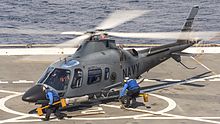
Philippine Navy AW109 during flight operations aboard the USS Green Bay
Beechcraft King Air - Maritime Patrol [41]
AgustaWestland AW109E – Multi-purpose naval helicopter[42]
AgustaWestland AW159 Wildcat - Anti-Submarine Warfare helicopter
Britten-Norman Islander – Maritime Patrol and as light utility transport.license production[43]
Cessna 172 – Training aircraft [44]
MBB Bo 105C – Utility helicopter[43]
Robinson R22 – Training helicopter [44]
Bases

Philippine Navy headquarters building along Roxas Boulevard, Manila.
In line with HPN General Order No. 229 dated 7 July 2009, the Philippine Navy has adopted new names for its bases and stations to pay homage to distinguished naval leaders. The new names, followed by the old names, are as follows:[45]
Naval Base Heracleo Alano (Naval Base Cavite) - Headquarters, Philippine Fleet- Naval Base Camilo Osias (Naval Operating Base San Vicente), San Vicente, Santa Ana, Cagayan
Naval Base Rafael Ramos (Naval Operating Base Mactan)[permanent dead link], Mactan, Cebu
- Naval Station Jose Andrada (Fort San Antonio Abad), City of Manila – Current headquarters of the Philippine Navy
- Naval Station Jose Francisco (Bonifacio Naval Station), Fort Bonifacio, Taguig City, Metro Manila
- Naval Station Heracleo Alano (Sangley Point), Cavite City
- Naval Station Pascual Ledesma (Fort San Felipe), Cavite City
- Naval Station Ernesto Ogbinar (Naval Station Poro Point), Poro Point, San Fernando, La Union – Headquarters of NAVFORNOL
Naval Station Leovigildo Gantioqui (Naval Station San Miguel), San Antonio, Zambales – Headquarters, NETC- Naval Station Apolinario Jalandoon (Naval Station Puerto Princesa), Puerto Princesa City, Palawan
- Naval Station Carlito Cunanan (Naval Station Ulugan), Ulugan, Palawan
- Naval Station Narciso Del Rosario (Naval Station Balabac), Balabac Island, Palawan
- Naval Station Emilio Liwanag (Naval Station Pag-asa), Pag-asa, Kalayaan Islands, Palawan
- Naval Station Julhasan Arasain (Naval Station Legaspi), Rawis, Legazpi City, Albay – Headquarters of NAVFORSOL
- Naval Station Alfonso Palencia (Naval Station Guimaras), Guimaras
- Naval Station Dioscoro Papa (Naval Station Tacloban), Tacloban City, Leyte
- Naval Station Felix Apolinario (Naval Station Davao), Panacan, Davao City – Headquarters of NAVFOREM
- Naval Station Romulo Espaldon (Naval Station Zamboanga), Calarian, Zamboanga City
- Naval Station Rio Hondo, Rio Hondo, Zamboanga City
- Naval Station Juan Magluyan (Naval Operating Base Batu-Batu), Panglima Sugala, Tawi-Tawi
Marine bases
- Marine Barracks Rudiardo Brown (Marine Base Manila), Fort Bonifacio, Taguig City, Metro Manila - Headquarters, Philippine Marine Corps
- Marine Barracks Gregorio Lim (Marine Base Ternate), Ternate, Cavite – Marine Basic School Campus
- Marine Barracks Arturo Asuncion (Marine Base Zamboanga), Zamboanga City
- Marine Barracks Domingo Deluana (Marine Base Tawi-Tawi), Tawi-Tawi
- Camp Gen. Teodulfo Bautista, Jolo, Sulu
The Philippine Navy, together with the entire armed forces as a whole, is embarking on its modernization program in line with the Philippine Navy Strategic Sail Plan 2020.[46]
The following equipment listed below are either scheduled for delivery or in the planning stages for the next 'horizons' of the AFP Modernization Program.
Multi-purpose attack crafts (MPAC)

A MPAC Mk3 of the Philippine Navy
The Philippine Navy received the first batch of three Taiwanese-built[47]Multi-purpose Attack Craft (MPAC), which are similar to the Swedish Combat Boat 90. These were presented during the 111th anniversary of the Philippine Navy in May 2009.[48]
These MPACs are around 15 meters long and are equipped with a water jet system. They have a maximum speed of 40 knots (74 km/h) and could reach around 300 nautical miles (560 km) while traveling on a transit speed of 30 knots (56 km/h). They are made of welded aluminum and can carry 16 fully equipped soldiers and four crew members or a payload of two tons. The ships are armed with one 50-caliber machine gun and two 7.62mm machine guns.[49]
Another MPAC, with modifications as compared to the first three units, was built by local company Propmech Corporation. It was received during the 114th anniversary celebrations of the Philippine Navy on 22 May 2012,[50] with two more delivered on 6 August 2012.[51][52][53] Up to 42 units are expected to enter service in the near future.[54][55]
In 2013, the PN announced that another batch of three MPACs will be procured between 2013 and 2017[56][57] An invitation to bid was released in 2014,[58] and it was also announced by the PN that the MPACs will be modernized, including the installation of better sensors and longer-ranged weapons like missiles.[59]
In February 2016, the DND awarded the contract to build 3 new MPACs, which are larger than the current ones in service, to a joint venture of Philippine company Propmech Corporation and Taiwanese shipyard Lung Teh Shipbuilding Co. Ltd.[60] A separate lot to acquire weapons systems was awarded to Rafael Advanced Defense Systems Ltd. of Israel, to supply Mini Typhoon 12.7mm RCWS with Spike-ER surface-to-surface missiles, plus ammunition and ILS.[61]
Multipurpose patrol vessels
Media reports of the Philippine Navy's plan to purchase three offshore patrol vessels were made, although there were initially no details available regarding their specifications.[62] However, only two units were listed as part of the priority items in the list for purchase between 2012 and 2016 presented by the armed forces to the House of Representatives’ committee on national defense and security last 26 January 2011.[63][64]
On 6 May 2011, a solicitation notice was posted on the United States Federal Business Opportunities (FBO) website on behalf of the Republic of the Philippines for "a general purpose Offshore Patrol Vessel (OPV)".[65]
Navantia submitted to Philippines the sophisticated patrol Avante 1800 to qualify for a bidding contest in 2013.[66]
During ADAS 2016, there was a newly revised wish list presented by the Philippine Navy wherein a sudden requirement for an Ocean Patrol Vessel was included. Based on the October 2016 AFP memorandum, the PN plans to have 6 to 9 ships of this type to replace the exact number of WW2-era ships presently in commission.[67]
Submarine
Reports as of May 2011 indicated that the Philippine Navy was eyeing the purchase of its first submarine not later than 2020, although no further details were provided.[68][69] The "Philippine Fleet Desired Force Mix" strategy concept publicly released in May 2012 indicates the requirement of at least three submarines for deterrence and undersea warfare to be available by 2020. Navy officials are said to be looking to acquire diesel electric powered submarines in 2018–2023,[55] or 2023–2028.[70]
Anti-submarine helicopters
A separate requirement for two anti-submarine helicopters worth Php 5.0 billion was also announced and would be funded by the AFP Modernization Program under the Medium Term Capability Development Program (MTCDP 2013–2017).[71][72]
On March 31, 2014, it was reported that the bidding for two anti-submarine helicopters worth Php5.4 billion would start on April 24, 2014.[73] AgustaWestland, which was considered the sole responsive bidder after a joint venture between Airbus Helicopters and PT Dirgantara Indonesia failed to meet the requirements during the 1st stage bidding. AgustaWestland went on to pass the 2nd stage bidding and post qualification stage,[74] and was awarded the project by the DND by 1st quarter of 2016. AgustaWestland offered their AW-159 Wildcat naval helicopter.[75]
The "Philippine Fleet Desired Force Mix" strategy concept publicly released in May 2012 indicated the requirement of at least 18 naval helicopters embarked on frigates and corvettes for anti-submarine warfare (ASW), over-the-horizon targeting (OTHT) for anti-ship missiles, and search & rescue (SAR).[55]
In March 2016, the Philippines was reported to have signed a contract to acquire 2 AgustaWestland AW159 Wildcat anti-submarine helicopters.[76]
Frigates
This requirement came out during the recent visit to Italy of a Philippine delegation led by Defense Secretary Voltaire Gazmin. The Philippine DND delegation signed an agreement with their Italian counterparts for possible purchase of Italian weapons systems. This visit included inspections of combat ready ships of the Maestrale and Soldati classes of the Italian Navy, which are scheduled for retirement, with the earliest possibly by 2013. No indication of sales were made yet.[77]
During the 2012 State of the Nation Address on 23 July 2012, the president announced that the Philippine Navy was canvassing for a frigate which would be delivered within 2013.[78]
At a DND press conference held on 2 August 2012, it was announced that negotiations were currently ongoing for the acquisition of 2 Maestrale-class frigates.[79][80] As of December 2012, the Italian defense minister Giampaolo di Paola confirmed that discussions were in the advanced stages.[81] The negotiations for the Maestrale-class ships did not materialize any sale, with the Philippine government opting to buy new frigates instead.[82]
On March 3, 2013, it was reported by the Philippine News Agency that a South Korean defense manufacturer had talked with the Department of National Defense regarding its requirements for two brand new frigates. The company offered the Philippine Navy varieties of the Incheon-class frigates.[83] Other countries reported to have offered new frigates were the United States, Israel, Croatia and Australia.[84]
In early October, DND announced the invitation to bid for the 2 brand-new frigates with an approved budget of Php18B. The package included a complete weapons system and must be delivered within 1,460 calendar days from the opening of the letter of credit. Pre-bidding was scheduled on October 11 and the first stage of bidding would be on October 25.[85]
On Dec. 7, 2013, it was reported that four firms had qualified for the next stage of the bidding: Navantia Sepi (RTR Ventures) of Spain and South Korean firms STX Offshore & Shipbuilding, Daewoo Shipbuilding & Marine Engineering and Hyundai Heavy Industries, Inc.[86] It was also reported that Garden Reach Shipbuilders & Engineers of India and STX France, SA of Europe qualified for the next stage of the bidding after the DND accepted the motions for reconsideration of the firms.[87] The project was later on divided into two lots after consultation with the bidders. Lot 1 with an approved budget of Php 16 billion was for the acquisition of the ships (platforms), guns and missile launchers. Lot 2 with an approved budget of Php 2 billion was for the acquisition of munitions, missiles, and torpedoes.
After several years of processing the acquisition, a Notice of Award was issued to Hyundai Heavy Industries on August 2016, with a contract expected to be signed very soon after. HHI previously mentioned that it was offering a derivative of their HDF-3000 frigate design.[88] Contract negotiations for the acquisition of the two vessels have been centered on the Philippine Navy requirement to secure not only the frigate's "design and technology transfers, but also training and skill sets to be applied to support a growth in Philippine shipbuilding capacity". This is intended to tie into the Philippine Navy Strategic Sail Plan 2020.[89]
A contract was signed between the Department of National Defense and Hyundai Heavy Industries on October 24, 2016, based on the Notice of Award provided earlier. Delivery of the Jose Rizal-class Frigate are expected to be completed by 2020.[87]
In addition to the new ships on bid, the navy is seeking to acquire two more frigates, probably used ones from the United States.[90]
The Philippine Navy has also shown its interest in acquiring modified Oliver Hazard Perry-class frigates from Australia, namely the Adelaide-class frigates. There are 3 remaining ships of the class on active service in the Royal Australian Navy and are due to be replaced by the newly built Hobart-class destroyers.[91]
Corvettes
It was reported that the Philippine Navy is in the market for four anti-submarine warfare (ASW) corvettes, each weighing at around 2,000 tonnes.[92] IHS Jane's reported on 8 August 2012 that the Philippine and Italian governments were in discussion for the possible purchase at least two Minerva-class corvettes.[93]
The Department of Foreign Affairs and Department of National Defense separately provided statements on an impending transfer of a Pohang-class corvette to the Philippine Navy before the end of 2014. No specifics on the ship for transfer was released, although it was said to still be in active service as of June 2014.[94][95][96]
After conducting the Joint Visual Inspection in Jinhae Naval Base in South Korea on April 2017, the Philippine Navy decided to finally accept the offer made by the South Korean government to transfer 1 corvette from the Pohang-class which was identified as the ROKS Chungju (PCC-762). The ship is expected to be in service with the Philippine Navy by 4th quarter of 2017.[97]
The Philippine Navy is also looking to acquire used warships from friendly countries, among those being considered are the decommissioned João Coutinho-class corvettes from Portugal as part of its plans to improve and renew its fleet of aging ships at the fastest possible time. The Philippine Navy is eyeing at least two ships as an initial requirement, with a follow-on third or fourth unit being considered should funding become available.[98]
Based on the "Philippine Fleet Desired Force Mix" strategy concept publicly released in May 2012, the Philippine Navy requires at least 12 corvettes for anti-submarine warfare (ASW) and with an embarked naval helicopter to be available by 2020.[55]
On the 28 of April 2017, The Philippine Government officially announced that the Philippine Navy will negotiate for a Flight III Pohang-class corvette from South Korea to boost its capabilities.[99][100][101]
Amphibious assault vehicles
In September 2013, the DND invited bidders for the Amphibious Assault Vehicles Acquisition Project of eight brand-new units of amphibious assault vehicles (AAV) for the Marines with Integrated Logistics Support (ILS) for the Philippine Navy, amounting to Php2.5B. Delivery is required for 850 days from the opening of the letter of credit. This acquisition is part of the PN's MRV/SSV or "Mother Ship" Project, which will serve as a platform for insertion of troops in beaches in an event of military siege.[102][103] By May 24, 2014, the DND announced that the South Korean firm of Samsung Techwin is the sole bidder for the DND-AFP's eight brand new amphibious assault vehicles.[104]
Missiles and other Weapons Systems

A Rafael Typhoon MLS-ER missile launcher with Spike-ER missiles as installed on one of the MPAC Mk. III attack boats
Spike-
ER short range surface-to-surface missiles- Typhoon MLS-ER missile launchers
Mini Typhoon 12.7mm
Remote Control Weapon Systems
To equip the various vessels and aircraft newly acquired by the navy, these weapons were ordered:
Spike NLOS surface-to-surface missiles
Mistral missiles in Simbad RC system
SSM-700K Haeseong anti-ship missiles
K745 Chung Sang Eo (Blue Shark) torpedoes- TLS-TT Shipboard Triple Torpedo Launching System
Gallery
.mw-parser-output .mod-gallery{display:table}.mw-parser-output .mod-gallery-default{background:transparent;margin-top:0.5em}.mw-parser-output .mod-gallery-center{margin-left:auto;margin-right:auto}.mw-parser-output .mod-gallery-left{float:left}.mw-parser-output .mod-gallery-right{float:right}.mw-parser-output .mod-gallery-none{float:none}.mw-parser-output .mod-gallery-collapsible{width:100%}.mw-parser-output .mod-gallery .title{display:table-row}.mw-parser-output .mod-gallery .title>div{display:table-cell;text-align:center;font-weight:bold}.mw-parser-output .mod-gallery .main{display:table-row}.mw-parser-output .mod-gallery .main>div{display:table-cell}.mw-parser-output .mod-gallery .caption{display:table-row;vertical-align:top}.mw-parser-output .mod-gallery .caption>div{display:table-cell;display:block;font-size:94%;padding:0}.mw-parser-output .mod-gallery .footer{display:table-row}.mw-parser-output .mod-gallery .footer>div{display:table-cell;text-align:right;font-size:80%;line-height:1em}.mw-parser-output .mod-gallery .gallerybox .thumb img{background:none}.mw-parser-output .mod-gallery .bordered-images img{border:solid #eee 1px}.mw-parser-output .mod-gallery .whitebg img{background:#fff!important}.mw-parser-output .mod-gallery .gallerybox div{background:#fff!important}

BRP Gregorio del Pilar steam in formation together with BRP Edsa during the sea phase of CARAT Philippines 2013
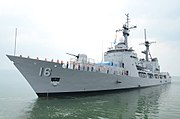
BRP Ramon Alcaraz (PF-16)
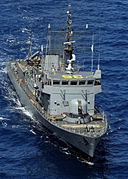
BRP Apolinario Mabini (PS-36) at Balikatan 2010 exercises.

BRP Tarlac (LD-601), a landing platform dock, sails underway to her delivery to the Philippines

BRP Bacolod City (LC-550), lead ship of the Bacolod City class Logistics Support Vessel, with USS Essex at Balikatan in 2008.
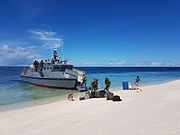
A Marine commando unit exhibits troop extraction from an indigenously-built Multipurpose Assault Craft
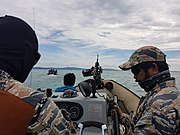
Philippine Navy Special Operations Group in a mission in Celebes Sea.
See also
- Armed Forces of the Philippines
- Philippine Army
- Philippine Air Force
- Philippine Marine Corps
- Philippine Coast Guard
- Philippine Constabulary
- Military History of the Philippines
References
- Citations
^ "PGMA's Speech during the 105th Founding Anniversary of the Philippine Navy". Archived from the original on 2007-10-08. Retrieved 2008-06-06..mw-parser-output cite.citation{font-style:inherit}.mw-parser-output .citation q{quotes:"""""""'""'"}.mw-parser-output .citation .cs1-lock-free a{background:url("//upload.wikimedia.org/wikipedia/commons/thumb/6/65/Lock-green.svg/9px-Lock-green.svg.png")no-repeat;background-position:right .1em center}.mw-parser-output .citation .cs1-lock-limited a,.mw-parser-output .citation .cs1-lock-registration a{background:url("//upload.wikimedia.org/wikipedia/commons/thumb/d/d6/Lock-gray-alt-2.svg/9px-Lock-gray-alt-2.svg.png")no-repeat;background-position:right .1em center}.mw-parser-output .citation .cs1-lock-subscription a{background:url("//upload.wikimedia.org/wikipedia/commons/thumb/a/aa/Lock-red-alt-2.svg/9px-Lock-red-alt-2.svg.png")no-repeat;background-position:right .1em center}.mw-parser-output .cs1-subscription,.mw-parser-output .cs1-registration{color:#555}.mw-parser-output .cs1-subscription span,.mw-parser-output .cs1-registration span{border-bottom:1px dotted;cursor:help}.mw-parser-output .cs1-ws-icon a{background:url("//upload.wikimedia.org/wikipedia/commons/thumb/4/4c/Wikisource-logo.svg/12px-Wikisource-logo.svg.png")no-repeat;background-position:right .1em center}.mw-parser-output code.cs1-code{color:inherit;background:inherit;border:inherit;padding:inherit}.mw-parser-output .cs1-hidden-error{display:none;font-size:100%}.mw-parser-output .cs1-visible-error{font-size:100%}.mw-parser-output .cs1-maint{display:none;color:#33aa33;margin-left:0.3em}.mw-parser-output .cs1-subscription,.mw-parser-output .cs1-registration,.mw-parser-output .cs1-format{font-size:95%}.mw-parser-output .cs1-kern-left,.mw-parser-output .cs1-kern-wl-left{padding-left:0.2em}.mw-parser-output .cs1-kern-right,.mw-parser-output .cs1-kern-wl-right{padding-right:0.2em}
^ ab "Philippine National Security". tagaloglang.com. Retrieved 2012-05-26.
^ "EC-OMB Corruption Prevention Project Integrity Development Review of the AFP-Philippine Navy Executive Summary" (pdf). Office of the Ombudsman-Philippines. October 2007. Retrieved 2012-07-26.
^ "EC-OMB Corruption Prevention Project Integrity Development Review of the AFP-Philippine Navy" (pdf). Office of the Ombudsman-Philippines. October 2007. Retrieved 2012-07-26.
^ "What is the Balangay?". balangay-voyage.com. Kaya ng Pinoy Inc. Retrieved 2012-07-21.
^ Roperos, Robert E. (2012-05-28). "Archeologists to resume excavation of remaining Balangay boats in Butuan". Philippine Information Agency (PIA). Archived from the original on 2012-12-21. Retrieved 2012-07-21.
^ It was integrated to the Spanish Empire through pacts and treaties (c.1569) by Miguel López de Legazpi and his grandson Juan de Salcedo. During the time of their hispanization, the principalities of the Confederation were already developed settlements with distinct social structure, culture, customs, and religion.
^ ab "3 of 5 Agusta choppers delivered to PH Navy". newsinfo.inquirer.net. Retrieved 2014-07-25.
^ Malkiel-Jirmounsky, Myron (1939). "The Study of The Artistic Antiquities of Dutch India". Harvard Journal of Asiatic Studies. Harvard-Yenching Institute. 4 (1): 59–68. doi:10.2307/2717905. JSTOR 2717905.
^ Tiongson, Jaime (2006-11-29). "Pailah is Pila, Laguna". Archived from the original on 2012-07-07. Retrieved 2008-02-05.
[unreliable source?]
^ Santos, Hector (1996-10-26). "The Laguna Copperplate Inscription". Archived from the original on 2014-11-21. Retrieved 7 October 2014.
^ abcdefghijklmn Zulueta, Joselito. "History of the Philippine Navy". Philippine Navy. Archived from the original on February 17, 2010. Retrieved 2012-07-21.
^ abcdefgh "THE PHILIPPINE NAVY" (pdf). dlsu.edu.ph. De La Salle University-Manila (ROTC). Retrieved 2012-07-21.
^ Morton, Louis. The War in the Pacific: Fall of the Philippines. p.11, 1953. Washington D.C.: U.S. Government Printing House, 1993.
^ "Remembering the Battle for Bataan, 1942", The Bataan Campaign Website,
February 22, 2014, Retrieved February 13, 2016.
^ Davis, David, LT, USMC, Page 14, "Introducing: The Philippine Navy", All Hands: The Bureau of Naval Personnel Career Publication, Number 558, Issue: July 1963, Retrieved February 18, 2016.
^ "PHILIPPINE SENATE VOTES TO REJECT U.S. BASE RENEWAL". The New York Times. Retrieved 2018-03-19.
^ "CLOSURE OF U.S. MILITARY BASES IN THE PHILLIPINES: IMPACT AND IMPLICATIONS" (PDF). dtic.mil. Retrieved 2018-03-19.
^ [1], Retrieved March 21, 2018.
^ [2], Retrieved March 21, 2018.
^ Mangosing, Frances G. "China military planes land on PH reef". Retrieved 2018-04-17.
^ [3], Retrieved March 21, 2018.
^ [4], Retrieved March 21, 2018.
^ [5], Retrieved March 21, 2018.
^ [6], Retrieved March 21, 2018.
^ [7], Retrieved March 21, 2018
^ [8], Retrieved March 21, 2018
^ [9], Retrieved March 21, 2018
^ [10], Retrieved March 21, 2018
^ [11], Retrieved March 21, 2018
^ [12], Retrieved March 21, 2018
^ [13], Retrieved March 21, 2018.
^ [14], Retrieved March 21, 2018.
^ [15], Retrieved March 21, 2018.
^ http://www.navy.mil.ph/pn_web_foicscorner.php
^ "Brief History of the Philippine Marine Corps". The Philippine Marine Corps. Archived from the original on 2013-08-31. Retrieved 2013-05-25.
^ abcde "GlobalSecurity.org - Philippine Navy Organization". GlobalSecurity.org. Retrieved 2010-03-24.
^ "Naval Education and Training Command". netc-navy.edu.ph. Archived from the original on 2009-04-22. Retrieved 2010-03-24.
^ "Naval Combat Engineering Brigade". Naval Combat Engineering Brigade.
^ "Japan to donate 5 navy training aircraft to Philippines". Nikkei Asian Review.
^ "The Philippine Navy to equip 2 of its AgustaWestland AW109 helicopters with combat equipment". December 2, 2013.
^ ab "World Air Forces 2014" (PDF). Flightglobal Insight. 2014. p. 23. Retrieved 2014-01-01.
^ ab "Naval Air Group Historical Events". Naval Air Group Philippine Navy. Archived from the original on 2013-12-01. Retrieved 2013-12-01.
^ Navy Today Navy Renames Bases and Stations after Predecessors
^ "The Navy Sail Plan". Manila Bulletin. 2010-09-10. Retrieved 2012-05-30.
^ "Abu Sayaff self-destructing by yearend". The Philippine Star. AFP. 2009-07-20. Archived from the original on 2013-01-31. Retrieved 2010-05-31.
^ "Teodoro tells Philippine Navy on its 111th anniversary: "Exceed your achievements"". Balita.ph. 2009-05-22. Retrieved 2010-05-31.
^ "Navy prepared to face inquiry". The Manila Times. 2009-05-22. Retrieved 2010-05-31.
[permanent dead link]
^ "Gazmin assures Navy of brand-new gear, assets showcased on Navy Day". InterAksyon.com. 2012-05-22. Retrieved 2012-05-22.
^ "Navy to receive 2 new multi-purpose attack craft". Philstar.com. 2012-07-31. Archived from the original on 2013-01-31. Retrieved 2012-08-02.
^ "Multi-Purpose Attack Craft". Philippine Navy - Naval Public Affairs Office. 2012-05-24. Archived from the original on 2012-06-15. Retrieved 2012-06-01.
^ "PH's new patrol boats". Reuters c/o Yahoo! News. 2012-08-06. Retrieved 2012-08-17.
^ "PH Navy needs bigger warships". ABS-CBN News. 2012-06-01. Retrieved 2012-06-01.
^ abcd "Philippine Navy needs P500B to upgrade war capability". Philstar.com. 2012-05-24. Archived from the original on 2014-03-10. Retrieved 2012-08-10.
^ "Navy in the market for three more Multi-Purpose Attack Crafts". PTV News. 2013-03-10. Retrieved 2013-03-14.
^ "PN to acquire 3 more multi-purpose assault vessels". ZamboTimes. 2013-09-21. Retrieved 2013-09-24.
^ "Invitation to bid | Multi-Purpose Attack Craft Acquisition Project (Lot 1)" (PDF). Republic of the Philippines Department of National Defense. 20 February 2014. Retrieved 2014-07-25.
^ "Navy's 6 MPACs for upgrade --Fabic". ptvnews.ph. Retrieved 2014-07-25.
^ "Filipino, Taiwanese firms to build missile platform Attack Crafts of Navy". Update.ph. 25 February 2016. Retrieved 2016-03-05.
^ "Israel's Rafael to supply weapons, missiles of Navy's Attack Crafts". Update.ph. 26 February 2016. Retrieved 2016-03-05.
^ "Navy planning to acquire seven vessels next year". Philstar Online. 2010-12-29. Archived from the original on 2013-11-08. Retrieved 2011-01-01.
^ "AFP submits P42B wish list to House defense panel". Malaya. 2011-01-27. Archived from the original on 2011-01-30. Retrieved 2011-01-29.
^ "AFP needs P42.1 billion for security program". Philstar Online. 2011-01-27. Archived from the original on 2013-01-31. Retrieved 2011-01-29.
^ "19--Offshore Patrol Vessel (OPV)". Federal Business Opportunities. 2011-05-06. Retrieved 2012-10-09.
^ "Navantia ha presentado a Filipinas el sofisticado patrullero Avante 1800 para optar al concurso que convocará a final de año". elconfidencialdigital.com. Retrieved 2014-07-25.
^ "The Multi-Purpose Patrol VEssel, The Philippine Navy's Newest Horizon 2 Project". maxdefense.blogspot.com. 2016-11-08.
^ "Philippine Navy bent on buying submarine". ABS-CBN News. 2011-05-12. Retrieved 2011-05-14.
^ "Philippines eyes submarines to boost navy". Inquirer.net. 2011-05-17. Retrieved 2011-05-17.
^ Parameswaran, Prashanth (24 February 2018). "Will the Philippines Ever Realize its Submarine Dream?". The Diplomat. Retrieved 2018-03-05.
^ "PN to get anti-submarine chopper". Philippines News Agency. 2013-04-30. Retrieved 2013-05-06.
[permanent dead link]
^ "Military to buy 2 anti-submarine choppers". The Philippine Star. 2012-11-19. Retrieved 2012-11-20.
^ "Bidding for P5.4-B helicopter deal set on April 24". The Philippine Star. 2014-03-31. Archived from the original on 2014-03-31. Retrieved 2014-03-31.
^ "Singapore Airshow 2016: Philippines enters final evaluation phase for AW159 helicopters". IHS Jane's 360. 2016-02-17. Retrieved 2016-03-24.
^ "Philippines selects Lynx Wildcat for ASW mission". IHS Jane's 360. 2016-03-23. Retrieved 2016-03-24.
^ http://www.mb.com.ph/brp-gregorio-velasquez-to-arrive-in-guam-on-saturday/
^ "Gazmin signs agreement with Italian Defense Minister". DND Office of Public Affairs. 2012-02-06. Retrieved 2012-02-15.
^ "FULL TEXT: English translation of State of the Nation Address 2012". ABS-CBN News. 2012-07-23. Retrieved 2012-07-25.
^ "Philippines mulling purchase of Italian frigates". Interaksyon.com. 2012-08-02. Archived from the original on 2015-02-17. Retrieved 2012-08-02.
^ Kington, Tom (2012-12-29). "Q and A with Giampaolo di Paola". DefenseNews. Retrieved 2012-12-27.
^ "No more second frigates for PN - DND official". Philippine News Agency. 2013-02-22. Archived from the original on 2013-11-13. Retrieved 2013-02-22.
^ Nepomuceno, Priam F. (2013-03-02). "South Korean defense manufacturer signifies interest to provide DND's frigate requirements". Philippines News Agency. Archived from the original on 2010-05-04. Retrieved 2013-05-25.
^ Nepomuceno, Priam F. (PNA) (2013-02-23). "Only brand new ships for Philippine Navy upgrade: DND official". InterAksyon.com. Archived from the original on 2013-05-28. Retrieved 2013-05-25.
^ Camille Diola (2013-10-03). "DND opens bidding for new P18-B warships". The Philippine Star. Retrieved 2013-10-04.
^ Alexis Romero (2013-12-07). "4 firms qualify for P18-B Navy frigate bidding". Philstar.com. Retrieved 2013-12-07.
^ ab Camille Diola (2014-05-01). "DND admits Indian, French shipbuilders to frigate program". The Philippine Star. Retrieved 2014-05-01.
^ Ridzwan Rahmat (2016-09-02). "Hyundai wins USD337 million frigate contract from Philippine Navy". IHS Jane's 360. Retrieved 2016-09-05.
^ Grevatt, Jon (5 October 2016). "PH looks to secure anti-piracy platforms". IHS Jane's Defence Weekly. 53 (40): 8.
^ "Philippines seeks US ships to counter China". Al Jazeera. 15 January 2014. Retrieved 2014-01-15.
^ "Australia's Adelaide-Class Frigates: Best and Last CHance for the Philippine Navy to Acquire Oliver Hazard Perry Frigates". maxdefense.blogspot.com. 25 April 2017.
^ "Regional Corvette and Frigate Programmes: Naval Expansion Continues". Asian Military Review. 18 (6). 2010-09-01. Archived from the original on 2010-10-25. Retrieved 2010-10-25.
^ Cohen, Michael: "Philippines Confirms T/A-50 Purchase", page 4. IHS Jane's Defence Weekly Volume 49 Issue 32, 8 August 2012.
^ "South Korea to Donate Corvette to PHL Navy before Yearend". Department of Foreign Affairs (Philippines). 2014-06-05. Retrieved 2014-06-06.
^ "South Korea gives Corvette to Philippine Navy". Inquirer.net. 2014-06-05. Retrieved 2014-06-06.
^ "Seoul to donate corvette warship to Phl navy". The Philippine Star. 2014-06-05. Retrieved 2014-06-06.
^ "Finally, The Philippine Navy (and Vietnam) Are Set to Receive a Pohang-Class Flight III Corvette Frm South Korea". maxdefense.blogspot.com. 2017-04-26.
^ "Used Warships As Stop Gap Measures to Replace World War 2 Assets of the Philippine Navy". maxdefense.blogspot.com. 2017-02-02.
^ "Finally, the Philippine Navy (and Vietnam) are Set to Receive a Pohang-class Flight III Corvette from South Korea". maxdefense.blogspot.com.
^ Nurw (28 April 2017). "DEFENSE STUDIES: DND to Acquire SK 'Pohang' ASW Corvette for USD100". defense-studies.blogspot.com.
^ "PH set to acquire Pohang-class corvette from South Korea". rappler.com.
^ "Amphibious Assault vehicle Acquisition Project" (PDF). Department of National Defense, Philippines. 2013-09-27. Archived from the original on 2014-06-29. Retrieved 2013-10-04.
^ "DND invites bidders for 8 Amphibious Assault Vehicles". AFPModernization.blogspot.com. 2013-09-29. Archived from the original on 2013-10-04. Retrieved 2013-10-04.
^ "South Korea’s Samsung Techwin sole bidder for 8 amphibious assault vehicles". angmalaya.net. Retrieved 2014-07-25.
- Bibliography
.mw-parser-output .refbegin{font-size:90%;margin-bottom:0.5em}.mw-parser-output .refbegin-hanging-indents>ul{list-style-type:none;margin-left:0}.mw-parser-output .refbegin-hanging-indents>ul>li,.mw-parser-output .refbegin-hanging-indents>dl>dd{margin-left:0;padding-left:3.2em;text-indent:-3.2em;list-style:none}.mw-parser-output .refbegin-100{font-size:100%}
- Philippine Navy. (1998). Tides of change. Manila: Philippine Navy.
- Philippine Navy. (2007). The Philippine Navy Strategic Sail Plan 2020 Book 1 2007. Manila: Philippine Navy
- Philippine Navy. (2014). " Rough Deck Log: 2014 Philippine Navy Anniversary Issue: To The Shores of Pusan: Combat Service Support and Escort Operations of the Philippine Navy in the Korean War (1950-1953)" by CDR Mark R Condeno
External links
| Wikimedia Commons has media related to Navy of the Philippines. |
- Philippine Navy Official Web Site
- AFP Armaments Upgrade Forum
- Armed Forces of the Philippines Forum
Philippine Naval Forces Recognition Guide - Opus224's Unofficial Philippine Defense Page (2004 – unmaintained page)
 Naval Sea Systems Command
Naval Sea Systems Command






